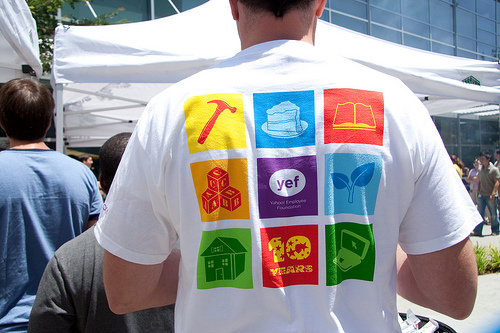
Image by Yodel Anecdotal on Flickr
 The world of charitable giving is undergoing its most radical transformation ever. As philanthropy has become democratized through the Internet and social media, Laura Arrillaga-Andreessen offers a timely, clear-eyed and inspiring assessment of the charitable landscape in her new book “Giving 2.0: Transform Your Giving and Our World” (Jossey-Bass).
The world of charitable giving is undergoing its most radical transformation ever. As philanthropy has become democratized through the Internet and social media, Laura Arrillaga-Andreessen offers a timely, clear-eyed and inspiring assessment of the charitable landscape in her new book “Giving 2.0: Transform Your Giving and Our World” (Jossey-Bass).
Arrillaga-Andreessen brings an impressive set of credentials to the table: A philanthropist, educator and social innovator, she founded the SV2 Silicon Valley Social Venture Fund, directs the Arrillaga Foundation and is president of the Marc and Laura Andreessen Foundation. (You’ll remember her husband, Mark, from his pioneering work as co-founder of Netscape.)
 In “Giving 2.0” the author sets out a personal, accessible account of her involvement in philanthropy as she challenges traditional assumptions about who can be – and should be – a philanthropist. In several chapters, she chronicles her own personal odyssey in the philanthropic world (“instead of establishing an organization designed to make money, I wanted to create one to give it away”) and offers accounts of people charting their own course in this new realm.
In “Giving 2.0” the author sets out a personal, accessible account of her involvement in philanthropy as she challenges traditional assumptions about who can be – and should be – a philanthropist. In several chapters, she chronicles her own personal odyssey in the philanthropic world (“instead of establishing an organization designed to make money, I wanted to create one to give it away”) and offers accounts of people charting their own course in this new realm.
Technology, she writes, has brought charitable giving to an astonishing new place: “Through technology you can raise your hand for a cause, and get other people to raise their hands with you. You can create a spark of social consciousness and watch it catch fire across national, or even global, communities.”
I was particularly glad to see her single out the work of Jolkona, a nonprofit that is at the forefront of this wave of one-to-one philanthropy. (See my interview with Jolkona founder Adnan Mahmud.) She also gives a shoutout to Catchafire, a startup that matches professionally skilled volunteers with nonprofits and social enterprises. (See my interview with Catchafire’s Jane Slusser.)
Ripple effects, giving circles and practical tips
Arrillaga-Andreessen invokes the big picture when writing about the connection between philanthropy and solutions to society’s most pressing social issues: “Global challenges such as poverty, poor education, disease and climate change can no longer be seen as isolated problems. The ripple effect of these things affects us all.” She recounts the rise of giving circles at the local level, such as Impact Austin, where thousands of women each give $1,000 a year and each has an equal voice when it comes to selecting grant recipients.
Along the way, she touches on B-corporations, L3Cs, social impact investing, the double bottom line and related subjects that will be familiar to those in the social enterprise space. Her narrative is fleshed out with an engaging cast of characters, including thought leaders in the field, such as Ashoka founder Bill Drayton: “Our job is not to give people fish. It’s not to teach them how to fish — it’s to build new and better fishing industries.”
The new volunteerism plays a prominent role in the book, and Arrillaga-Andreessen trots out an impressive array of statistics to bolster her case that the cause-filled life has never been more central to the American experience: Some 63 million Americans volunteer in organizations ranging from the Rotary Club to VolunteerMatch, Crowdrise and Catchafire. Americans now devote more than $200 billion and 8.1 billion hours of volunteer work each year. (The book could have benefited from a deeper dive into the new breed of social entrepreneurship.)
While “Giving 2.0” offers a high-level road map for the new philanthropy, Arrillaga-Andreessen also offers practical, real-world tips at the end of each chapter with a “Making It Happen” set of useful suggestions. I’ll be keeping “Giving 2.0” within reach on my bookshelf as a Big Ideas resource to cite when commenting on the changing face of philanthropy in America in the years ahead.
See the Giving 2.0 website, or buy Giving 2.0 on Amazon.JD Lasica, founder and former editor of Socialbrite, is co-founder of Cruiseable. Contact JD or follow him on Twitter or Google Plus.
 This work is licensed under a Creative Commons Attribution 3.0 Unported.
This work is licensed under a Creative Commons Attribution 3.0 Unported.








